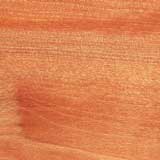|
American Sycamore belongs to the Planetree family and is the most important of the seven species native to the United States, Mexico and Central America. It is sometimes known as Planetree, Button-Ball or Buttonwood and is one of the largest trees of eastern United States. It grows to 80 or 100 feet high and 3 to 8 feet in diameter scattered in a mixture with other hardwood trees found along stream banks and in bottomland.
Sycamore grows widely in the eastern half of the country but a greater portion of the lumber comes from bottomlands along the Mississippi River and its tributaries. Its general distribution is throughout the eastern half of the country from northern Maine to northeastern Nebraska, south into Texas and along the Gulf of Mexico to northern Florida, including Tennessee. A good quantity of Sycamore lumber is cut for use as drawer stock by the furniture industry. Quartered Sycamore is also enjoying increased popularity in veneer and plywood form for furniture, interior finish and wall paneling. In quarter-sliced veneer, Sycamore presents a prominent flake figure to impart an attractive mottled texture. A pleasing ribbon stripe is also produced by selective cutting. This Sycamore veneer is very popular for veneered bedroom furniture finished in light novelty finishes which do not obscure the grain. The sapwood of Sycamore will range in color from brownish white to pale reddish brown or silvery brown and the heartwood from pale brown to dark brown with either a reddish or silvery tinge. The color difference between sapwood and heartwood is moderate and blends together in a single board rather than standing out in bold relief. Some trouble is experienced with seasoning plain-sawn Sycamore but quarter-sawed lumber seasons well under controlled drying conditions. The wood is of fine, uniform texture, moderately heavy and hard, and is generally rated as intermediate in strength stiffness and shock resistance properties. It has unusual resistance against splitting due to its interlocked fiber, somewhat like gum. Sycamore has proved to be an excellent wood for the manufacture of butcher blocks and shipping containers for candy, foods, vegetable and dairy products as it has no tendency to impart either odor or taste. This property has also led to its use for tobacco boxes, fruit and berry boxes, and flour and sugar barrels. It is commonly used for piano backs and bodies for stringed instruments, such as guitars and mandolins. Sycamore is also used in limited quantities for the manufacture of agricultural implements, small boats, brush blocks, carpet sweepers, refrigerators, handles, shade rollers, vehicle bodies and laundry appliances. Quartered Sycamore is especially attractive for wall paneling and interior trim. It is used for risers, floors, veneer doors and interior decoration. Furniture, fixtures, millwork and caskets also take a considerable amount of this stock. Sycamore is one of the most beautiful of the hardwoods in its quartered form. Modern seasoning and machining practices has removed most of the difficulties previously experienced with its preparation. Sycamore takes a beautiful finish and it has an excellent appearance with a natural finish. |

